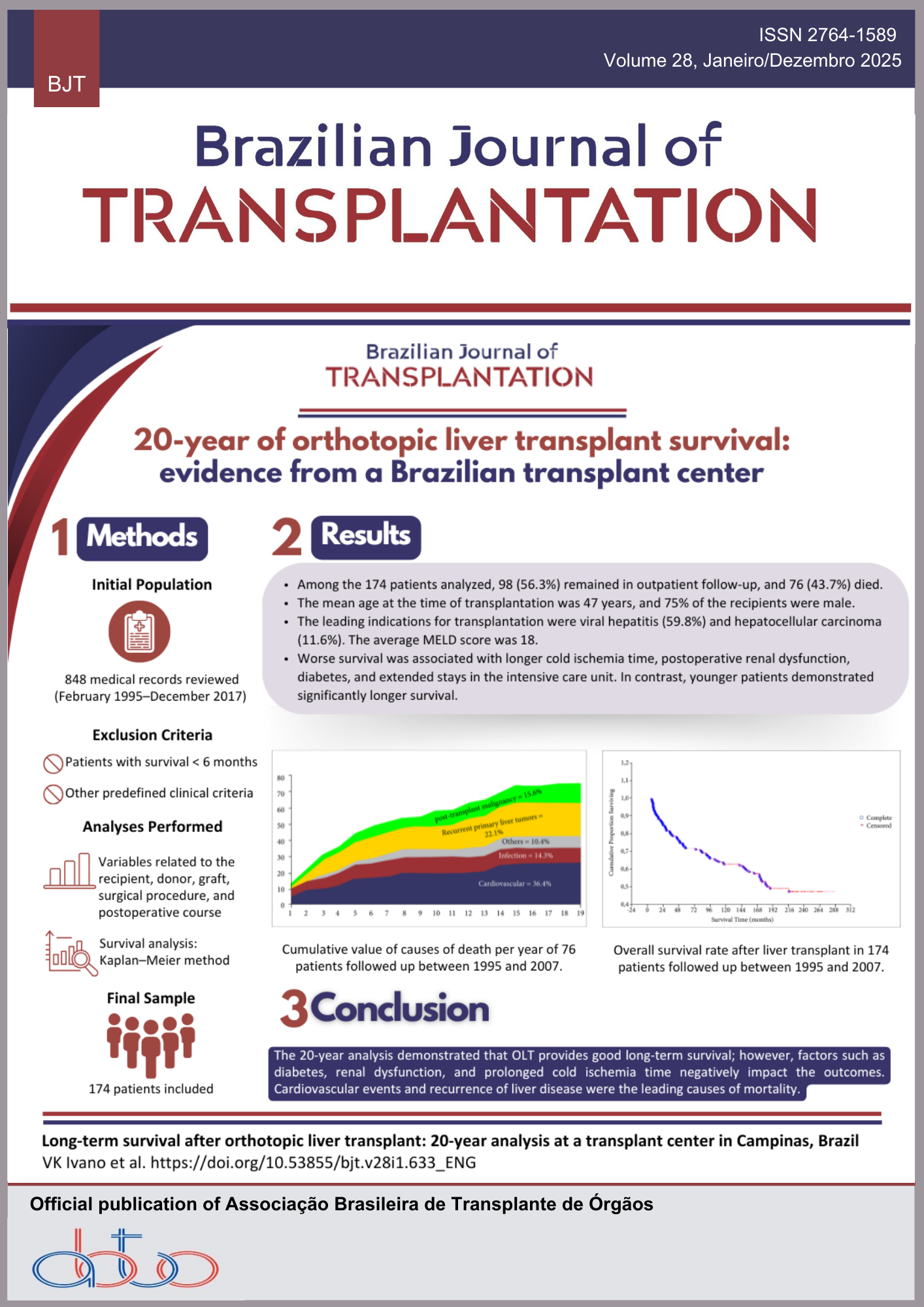Reinsertion into the Labor Market for Liver Transplant Recipients: Evidence from a Transplant Unit
Keywords:
Liver Transplant, Liver diseases, Health Care, Quality of Life, Job MarketAbstract
Introduction: The world's pioneering liver transplant occurred on March 1, 1963. In Brazil, the initiative for this procedure took place in 1968 at the Hospital das Clínicas, Universidade de São Paulo. Liver transplantation should only be indicated when conventional therapeutic methods have been exhausted, with the probability of survival and quality of life being greater with the procedure. Objectives: To statistically and econometrically analyze the reintegration into the labor market of post-liver transplant patients followed in a liver transplant unit in the state of Pernambuco who underwent the procedure from 2012 to 2021. Methods: A descriptive, cross-sectional study with a quantitative approach was carried out at the Unidade de Transplante de Fígado (UTF), Hospital Universitário Oswaldo Cruz (HUOC). The following inclusion criteria were used: age over 18 years, patients who were in the labor market before liver transplantation, and workers in the same sector who did not undergo the procedure. To analyze the collected data, the difference-in-differences statistical technique, event study, was used, since the treatment of the treated group occurred on different occasions within the researched period. During this period, individuals who had not yet received surgical treatment acted as a control group for those who had already undergone liver transplantation. Results: Liver transplantation reduced the chances of employability of patients followed up at the UTF/HUOC by 20%, despite the increased survival of these patients after the procedure. Conclusion: The study concluded that the high unemployment rate among the transplanted population indicates that these individuals are more predisposed to informal employment, causing a greater tendency to infectious diseases and a lower level of education due to less opportunity for professional improvement.
Downloads
References
1. Pacheco L. Transplante de fígado no Brasil. Rev Col Bras Cir, 2016;43(4):223-4. https://doi.org/10.1590/0100-69912016004014
2. Lacerda CM, Melo PSV, Lucena O, Amorim A, Almeida HM, Pereira LB. Transplante de fígado em hospital universitário do Recife: resultados iniciais Rev. Col. Bras. Cir. 30 (1), 2003. https://doi.org/10.1590/S0100-69912003000100006
3. Lucena O, Amorim AG, Sabat B, Adeodato LCL, Miranda LEC, Lacerda CM. Transplante de fígado a partir de doadores em assistolia: resultados iniciais do grupo de transplante de fígado do Hospital Oswaldo Cruz, Universidade de Pernambuco. Rev Col Bras Cir, 2005; 32(5). https://doi.org/10.1590/S0100-69912005000500010
4. Associação Brasileira de Transplante de Órgãos. Dimensionamento dos transplantes no Brasil e em cada estado (2016-2023). Registro Brasileiro de Transplantes. 2023 [access on 30 Apr 2024]; XXX(4). Available in: https://site.abto.org.br/wp-content/uploads/2024/03/RBT_2023-Populacao_Atualizado.pdf
5. Ahmed A, Keeffe EB. Current indications and contraindications for liver transplantation. Clin Liver Dis, 2007; 11(2): 227-47. https://doi.org/10.1016/j.cld.2007.04.008
6. Fernandes RC, Soler WV, Pereira WA. Diretrizes básicas para captação e retirada de múltiplos órgãos e tecidos da Associação Brasileira de Transplante de Órgãos. São Paulo: Associação Brasileira de Transplante de Órgãos; 2009.
7. Grogan TA. Liver transplantation: issues and nursing care requirements. Crit Care Nurs Clin North Am. 2011 [access on 12 Dec 2023]; 23(3): 443-56. Available in: https://www.ccnursing.theclinics.com/article/S0899-5885(11)00030-X/abstract
8. Hackl C, Schlitt HJ, Melter M, Knoppke B, Loss M. Current developments in pediatric liver transplantation. World J Hepatol, 2015; 7(11): 1509-20. https://doi.org/10.4254/wjh.v7.i11.1509
9. Carvalho WN. Sobrevida de pacientes após o transplante cardíaco e análise da qualidade de vida relacionada à saúde: dados de um centro transplantador brasileiro. Dissertation [Master in Medicine] –Universidade Federal de Minas Gerais; 2019. http://hdl.handle.net/1843/32520
10. Aguiar MIF. Transplante hepático: o significado para aqueles que vivenciam a espera procedimento cirúrgico. Dissertation (Mater in Nursing) – Universidade Federal do Ceará; 2007. http://repositorio.ufc.br/handle/riufc/1848
11. Ponce TD, Picciano AP, Vargas D. Women’s alcohol consumption in a primary health care service. Rev Esc Enferm USP, 2021; 55: e20200458. https://doi.org/10.1590/1980-220X-REEUSP-2020-0458
12. Brathwaite T, Walker JL. Causal inference in travel demand modeling (and the lack thereof). J Choice Model, 2017; 26: 1-18. https://doi.org/10.1016/j.jocm.2017.12.001
13. Pearl J. Causality: models, reasoning, and inference. Cambridge: Cambridge University; 2001.
14. Schittkowski K. Numerical data fitting in dynamical systems: a practical introduction with applications and software. Dordrecht, Kluwer Academic Publishers; 2013.
15. Meade N, Islam T. Prediction intervals for growth curve forecast. J Forecast, 1995; 14(5): 413-30. https://doi.org/10.1002/for.3980140502
16. Izbicki S. Machine learning sob a ótica estatística. São Paulo: UFScar/INSPER; 2018.
17. Gertler P, Martínez S, Premand P, Rawlings L, Vermeersch C. A avaliação do impacto na prática. Washington, D.C.: Banco Mundial; 2011.
Downloads
Published
How to Cite
Issue
Section
License
Copyright (c) 2025 Laísa Darlem da Silva Nascimento

This work is licensed under a Creative Commons Attribution 4.0 International License.









